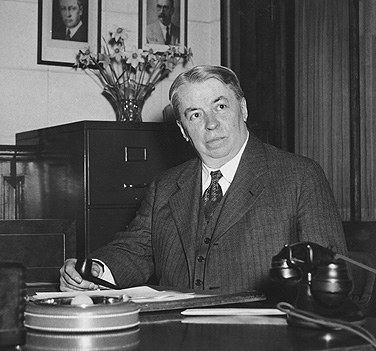Flashback
90 years ago
UB’s first paid administrator

George Crofts, UB’s first paid administrator, spent 30 years as university treasurer and comptroller. Photo: UB Archives
“Buffalo’s greatest enterprise” was how George D. Crofts described UB. As UB’s treasurer and comptroller for 30 years, Crofts was the one most responsible for the university’s fiscal stability during periods of depression and world war. On July 11, 1921—the day Crofts assumed his new responsibilities—UB had its first paid administrator.
Born in Buffalo in 1880, Crofts received his bachelor’s and law degrees from Cornell. During his summer breaks, Crofts worked as a reporter for the “Buffalo Courier” and in 1901, he covered the Pan-American Exposition. On the afternoon of Sept. 6—the day President William McKinley was shot while visiting the exposition—Crofts was the only reporter in the newspaper office.
Young Crofts was sent to the John G. Milburn home on Delaware Avenue, where McKinley had been taken to convalesce after surgery for his gunshot wound. As the “Buffalo Evening News” reported many years later, Crofts arranged for the exclusive use of the telephone in a house across the street from the Milburn residence. When McKinley died in the early morning of Sept. 14, Crofts was able to use the open telephone line to scoop the other reporters. He received a $50 bonus for the story.
In 1904, Crofts was appointed lecturer in the Law School. During World War I, he worked with Walter P. Cooke on the Liberty Loan campaigns, and in 1920, it was Crofts who convinced a reluctant Cooke to head UB’s first capital campaign. At the conclusion of a successful campaign with $5 million in pledges in hand, the UB Council, chaired by Cooke, named William H. Crosby to the new position of treasurer and comptroller. Already retired from business and not interested in a new job, Crosby quickly relinquished the post to the younger Crofts.
Prior to 1920, the individual professional schools and the College of Arts and Sciences operated independently, with no uniform means of budgeting or accounting for receipts and disbursements. Not unlike the way in which Samuel P. Capen—who became chancellor in 1922—brought the academic activities of the different areas together to form a centralized university, Crofts organized a central business office and instituted an appropriate accounting system for the university. During Crofts’ tenure, the position of treasurer and comptroller was at the same level as chancellor, with both reporting to the University Council.
The years between and 1920 and 1932 were difficult ones for UB, a period that Crofts would later refer to as the “12 unhappy years of operating deficits.” Each of those years, Crofts had to seek bank loans to cover the shortfall. The aggregate deficit was not paid off until the early 1940s.
UB’s financial situation did improve. The budget in 1921 was $290,000. It was $4 million at the time of Crofts’ retirement in 1952. During the same period, the endowment rose to more than $8 million, and physical assets increased from $782,000 to almost $10 million.
Capen likened Crofts to ”the chief engineer of an ocean liner, who lives below decks, who is not very often seen on the decks, who sometimes dines with passengers, but is responsible for making the ship go.”
Crofts Hall on the North Campus is named for George D. Crofts. The University Archives hold the correspondence files, from 1921-1951, of the Office of the Treasurer and Comptroller, and a collection of financial ledgers and journals for the same period. Additional information regarding Crofts’ role in UB capital campaigns is located in “University fund raising records, 1920-1953.”
—John Edens, University Archives

Reader Comments
Shonnie Finnegan says:
Emily Webster would be so pleased with this excellent article!
Posted by Shonnie Finnegan, University Archivist Emerita, 07/14/11